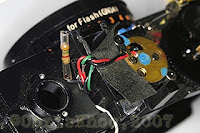Olympus Pen-EE-3 : Removing the Top and Bottom covers (for cleaning, etc.)
Removing the Top Cover
Tools used: Micro/Jeweller's screwdrivers (flat & cross head), tweezers, small spanner and a wooden chop-stick!
1) Remove the screw just under the strap lug.
2) Remove the screw which holds the rewind crank lever.
3) Remove the rewind crank lever top. (I've used a wooden chop-stick* to hold the 'teeth' of the film holder pin, and the end of a small spanner which fits into the gap** where the rewind lever sits).
*Some people use the shaft of a small screw driver, I prefer not to: the wood doesn't have any risks of scratching the insides of where the film canister sits.
** I once tried to unscrew a similar top configuration on another camera, using the actual rewind crank lever, and unfortunately the top was so tight that it needed a lot of effort to 'turn' - during my effort I bent the lever! From then on I decided to try to get more leverage-surface coverage by using the end of a small spanner in the space where the lever would sit :-)
4) Remove the two screws in the rewind crank lever bay.
The Top off the camera. (Note the cable which is connected to the Hot-Shoe)
A closer inspection finds dirt (!) under one end of the tape which holds the cover for the VF lenses.
Note: The cover which covers the VF lenses is made of card! BE CAREFUL if removing the tape which holds this cover in place.
With a little care, the cover can be bent outwards to allow access to the VF lenses for cleaning.
SOMETHING TO REMEMBER WHEN CLEANING THE VIEW FINDER LENS (OR ANY OTHER LENS) - What ever fluid* you use TREAT ALL THE GLASS PIECES AS IF IT WERE YOUR EYES (you wouldn't start rubbing the fluid in with 'heavy pressure', would you?)
*I use an Isopropyl Alcohol solution, applied with a cotton bud stick (Q-Tip, etc.) A couple of drops of fluid on one end; the other end of the bud stick 'dry?. I apply the 'wet' end lightly/liberally and then immediately pass the dry end over.
VF cover re-taped (I've used 'normal' wiring tape)
Removing the Bottom Cover
Only two screws to remove on the bottom cover:
When removing the bottom cover, the rewind-button might fall out. It's actually held in place by a small clip. To insert the rewind button in its place, the clip has to be moved outwards first. If you try to force the rewind button in, without moving the clip, you'll either bend the clip or break it!
TO REPLACE THE COVERS: Just follow the above sequences in reverse order.
Sunday, December 30, 2007
Saturday, December 29, 2007
Olympus Pen-EE-3 Reseal
The Olympus Pen-EE-3
One of my favourite carry-everywhere/anywhere street shooters. Despite being a 'half-frame' format, the quality of the lens gives some excellent, well focused results.



Scraping off the old seals at the door end

Old seals completely removed

...

Fitting sealing material (strips of 1.5mm width) into the slots/rails. NO GLUE USED. The width of the seal squeezes nicely into the slots and gluing is unnecessary.
Fitting seals into the lower slots

Fitting seals into the upper slots

New seals in place!
 A thicker 'seal' which actually acts more like a 'cushion' for the film canister is placed at the door end
A thicker 'seal' which actually acts more like a 'cushion' for the film canister is placed at the door end

One of my favourite carry-everywhere/anywhere street shooters. Despite being a 'half-frame' format, the quality of the lens gives some excellent, well focused results.

This Olympus Pen-EE3 is in desperate need of new light seals.
Some small bits of the old seals have stuck on to other areas inside the camera

After soaking the old seals with a few drops of isopropyl alcohol (lens/glass cleaning fluid) for a few minutes, removal is made easier. A bamboo barbecue stick shaped to a flat-spatula-like shape at one end serves well. Being wood it doesn't scratch the paint. (Every time the end gets dirty, just cut-off the end and re-shape.)
Scraping off the old seals at the door hinge
Scraping off the old seals at the door end

Old seals completely removed

...

Fitting sealing material (strips of 1.5mm width) into the slots/rails. NO GLUE USED. The width of the seal squeezes nicely into the slots and gluing is unnecessary.
Fitting seals into the lower slots

Fitting seals into the upper slots

New seals in place!
 A thicker 'seal' which actually acts more like a 'cushion' for the film canister is placed at the door end
A thicker 'seal' which actually acts more like a 'cushion' for the film canister is placed at the door end
Monday, December 24, 2007
Olympus Trip 35 Reseal (Replacing Light Seals)
Replacing the light seals on an Olympus Trip 35 is easier than you think!
So: When does one need to have the light seals replaced?
The answer is very simple: Even BEFORE the light seals have turned hard and 'crumbly', deteriorated or even disintegrated, there is a point where the spongy-like material has become soft and sticky, like tar... And it's messy stuff!
Just as well, replacing the light seals is a very easy D.I.Y. task which only needs a little bit of effort and patience. My task was made even easier when I got myself an INTERSLICE light sealing kit (online store*). I opted for the larger kit, and it came with a varied selection of different thicknesses and widths of self adhesive seal material: Two types of 'material'; "foam" type and "fabric/felt" type. The instructions include diagrams and lots of advice and tips. Highly recommended and great value for money, (Look for "INTERSLICE" on Ebay, or contact: Jgood21967_at_aol_dot_com (email reproduced with permission.)
*BTW: I DON'T get a commission for sales! I did quite a bit of research into looking for suitable materials for renewing the light seals on my cameras. Many alternatives are available, as also some 'specific' kits for particular cameras, e.g. Pre-cut-out/shaped seals. However, because I have quite a few cameras that need new seals (and others that would benefit) my best option taking into consideration the COST, the INTERSLICE kit was the ONLY choice for me.
For my first attempt, I chose one of my Olympus Trip 35 cameras. The camera only had light seals at the door hinge (a strip on the body and a strip on the door), and two short lengths in the slots at the hinge corner (upper and lower slots.)

The old seals had become sticky, and when touched, my finger was left with a black messy tar-like substance! There were also small bits of this stuff inside the camera. Those bits could have ruined a great picture if any of it had gotten on to the film!
First, I 'soaked' the old seals with an Isopropyl Alcohol solution (also used for cleaning lenses). This would help 'loosen' the old seals and adhesive. Then, using a thin wooden stick (shaped flat with a cutter) I started to scrap off the old seals. (The Interslice kit comes with a shaped wooden stick, but, for my first attempt, and because the old seals were so sticky and gooey, I decided to make my own 'cleaning sticks' from wooden barbecue sticks (actually bamboo wood: a packet of 50 sticks cost me 0.80€ (Euros) (about US$1.00) in a typical 1€ store). Because the sticks are so cheap, every time a bit got dirty, I just cut the end off - and when there wasn't enough 'end' to cut off, I just used another stick.
So: When does one need to have the light seals replaced?
The answer is very simple: Even BEFORE the light seals have turned hard and 'crumbly', deteriorated or even disintegrated, there is a point where the spongy-like material has become soft and sticky, like tar... And it's messy stuff!
Just as well, replacing the light seals is a very easy D.I.Y. task which only needs a little bit of effort and patience. My task was made even easier when I got myself an INTERSLICE light sealing kit (online store*). I opted for the larger kit, and it came with a varied selection of different thicknesses and widths of self adhesive seal material: Two types of 'material'; "foam" type and "fabric/felt" type. The instructions include diagrams and lots of advice and tips. Highly recommended and great value for money, (Look for "INTERSLICE" on Ebay, or contact: Jgood21967_at_aol_dot_com (email reproduced with permission.)
*BTW: I DON'T get a commission for sales! I did quite a bit of research into looking for suitable materials for renewing the light seals on my cameras. Many alternatives are available, as also some 'specific' kits for particular cameras, e.g. Pre-cut-out/shaped seals. However, because I have quite a few cameras that need new seals (and others that would benefit) my best option taking into consideration the COST, the INTERSLICE kit was the ONLY choice for me.
For my first attempt, I chose one of my Olympus Trip 35 cameras. The camera only had light seals at the door hinge (a strip on the body and a strip on the door), and two short lengths in the slots at the hinge corner (upper and lower slots.)
The old seals

The old seals had become sticky, and when touched, my finger was left with a black messy tar-like substance! There were also small bits of this stuff inside the camera. Those bits could have ruined a great picture if any of it had gotten on to the film!
First, I 'soaked' the old seals with an Isopropyl Alcohol solution (also used for cleaning lenses). This would help 'loosen' the old seals and adhesive. Then, using a thin wooden stick (shaped flat with a cutter) I started to scrap off the old seals. (The Interslice kit comes with a shaped wooden stick, but, for my first attempt, and because the old seals were so sticky and gooey, I decided to make my own 'cleaning sticks' from wooden barbecue sticks (actually bamboo wood: a packet of 50 sticks cost me 0.80€ (Euros) (about US$1.00) in a typical 1€ store). Because the sticks are so cheap, every time a bit got dirty, I just cut the end off - and when there wasn't enough 'end' to cut off, I just used another stick.
Scraping off the old seals
After cleaning all the old seals and completely removing all the residue, it was time to cut the new seals. A good ultra sharp cutter and ruler!, and a few measurements, and a few cuts, and "voila" new light seals ready!
(Side note: I'm also 'overhauling' another Oly Trip 35, which will include the 'shutter speed' modification to be able to use the 200th speed on 'flash'.. and possibly a 'B' setting. AND, repainting and re-covering - colours yet to be decided!)
One Olympus Trip 35 ready for action!...... almost..... The 'plastic-pseudo-leatherette' covering has shrunk! and is starting to peel away at one corner, which actually, is great: I want to re-cover the body, although I just can't decide if I'll do it in Black (my favourite colour) or something a little bit 'funky'.
(Side note: I'm also 'overhauling' another Oly Trip 35, which will include the 'shutter speed' modification to be able to use the 200th speed on 'flash'.. and possibly a 'B' setting. AND, repainting and re-covering - colours yet to be decided!)
Labels:
Interslice,
light-seals,
Olympus Trip 35,
reseal
Subscribe to:
Posts (Atom)















